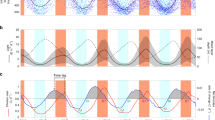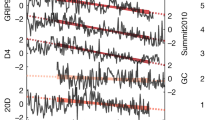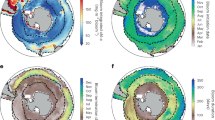Abstract
Polar plankton communities are among the most productive, seasonally dynamic and rapidly changing ecosystems in the global ocean. However, persistent cloud cover, periods of constant night and prevailing low solar elevations in polar regions severely limit traditional passive satellite ocean colour measurements and leave vast areas unobserved for many consecutive months each year. Consequently, our understanding of the annual cycles of polar plankton and their interannual variations is incomplete. Here we use space-borne lidar observations to overcome the limitations of historical passive sensors and report a decade of uninterrupted polar phytoplankton biomass cycles. We find that polar phytoplankton dynamics are categorized by ‘boom–bust’ cycles resulting from slight imbalances in plankton predator–prey equilibria. The observed seasonal-to-interannual variations in biomass are predicted by mathematically modelled rates of change in phytoplankton division. Furthermore, we find that changes in ice cover dominated variability in Antarctic phytoplankton stocks over the past decade, whereas ecological processes were the predominant drivers of change in the Arctic. We conclude that subtle and environmentally driven imbalances in polar food webs underlie annual phytoplankton boom–bust cycles, which vary interannually at each pole.
This is a preview of subscription content, access via your institution
Access options
Subscribe to this journal
Receive 12 print issues and online access
$259.00 per year
only $21.58 per issue
Buy this article
- Purchase on Springer Link
- Instant access to full article PDF
Prices may be subject to local taxes which are calculated during checkout




Similar content being viewed by others
References
Hoge, F. E. et al. Airborne lidar detection of subsurface oceanic scattering layers. Appl. Opt. 27, 3969–3977 (1988).
Churnside, J. H., Sawada, K. & Okumura, T. A comparison of airborne lidar and echo sounder performance in fisheries. J. Mar. Acoust. Soc. Jpn 28, 175–183 (2001).
Churnside, J. H. & Thorne, R. E. Comparison of airborne lidar measurements with 420 kHz echo-sounder measurements of zooplankton. Appl. Opt. 44, 5504–5511 (2005).
Dickey, T. D., Kattawar, G. W. & Voss, K. J. Shedding new light on light in the ocean. Phys. Today 64, 44–49 (April, 2011).
Behrenfeld, M. J. et al. Space-based lidar observations of global ocean plankton populations. Geophys. Res. Lett. 40, 4355–4360 (2013).
Winker, D. M. et al. Overview of the CALIPSO Mission and CALIOP data processing algorithms. J. Atmos. Ocean. Technol. 26, 2310–2323 (2009).
Babin, M. & Forget, M.-H. in Ocean Colour Remote Sensing of Polar Regions (eds Babin, M., Arrigo, K., Bélanger, S. & Forget, M.-H.) Ch. 1 (Reports of the Ocean Colour Coordinating Group, IOCCG, 2015).
Churnside, J. H., McCarty, B. J. & Lu, X. Subsurface ocean signals from an orbiting polarization lidar. Remote Sens. 5, 3457–3475 (2013).
Lu, X., Hu, Y., Trepte, C., Zeng, S. & Churnside, J. H. Ocean subsurface studies with the CALIPSO spaceborne lidar. J. Geophys. Res. 119, 4305–4317 (2014).
Behrenfeld, M. J., Boss, E., Siegel, D. A. & Shea, D. M. Carbon-based ocean productivity and phytoplankton physiology from space. Glob. Biogeochem. Cycles 1, GB1006 (2005).
Westberry, T. K., Behrenfeld, M. J., Siegel, D. A. & Boss, E. Carbon-based primary productivity modeling with vertically resolved photoacclimation. Glob. Biogeochem. Cycles 22, GB2024 (2008).
Graff, J. R. et al. Analytical phytoplankton carbon measurements spanning diverse ecosystems. Deep-Sea Res. 102, 16–25 (2015).
Behrenfeld, M. J. & Boss, E. S. Resurrecting the ecological underpinnings of ocean plankton blooms. Ann. Rev. Mar. Sci. 6, 167–194 (2014).
Evans, G. T. & Parslow, J. S. A model of annual plankton cycles. Biol. Oceanogr. 3, 327–347 (1985).
Behrenfeld, M. J. Climate-mediated dance of the plankton. Nat. Clim. Change 4, 880–887 (2014).
Stroeve, J. C. et al. Trends in Arctic sea ice extent from CMIP5, CMIP3 and observations. Geophys. Res. Lett. 39, 16, L16502 (2012).
Cavalieri, D. J., Gloersen, P., Parkinson, C., Comiso, J. & Zwally, H. J. Observed hemispheric asymmetry in global sea ice changes. Science 278, 1104–1106 (1997).
Arrigo, K. R. & van Dijken, G. L. Continued increases in Arctic Ocean primary production. Prog. Oceanogr. 136, 60–70 (2015).
Arrigo, K. R., van Dijken, G. L. & Bushinsky, S. Primary production in the Southern Ocean, 1997–2006. J. Geophys. Res. 113, C08004 (2008).
Boyd, P. W. et al. Mesoscale iron enrichment experiments 1993–2005: synthesis and future directions. Science 315, 612–617 (2007).
de Baar, H. J. W. et al. Synthesis of iron fertilization experiments: from the Iron Age in the Age of Enlightenment. J. Geophys. Res. 110, C09S16 (2005).
Ichimi, K., Kawamura, T., Yamamoto, A., Tada, K. & Harrison, P. J. Extremely high growth rate of the small diatom Chaetoceros salsugineum isolated from an estuary in the eastern Seto inland sea, Japan. J. Phycol. 48, 1284–1288 (2012).
Furnas, M. J. In situ growth rates of marine phytoplankton: approaches to measurement, community and species growth rates. J. Plank. Res. 12, 1117–1151 (1990).
Brand, L. E. & Guillard, R. R. L. The effects of continuous light and light intensity on the reproduction rates of twenty-two species of marine phytoplankton. J. Exp. Mar. Biol. Ecol. 50, 119–132 (1981).
Mahadevan, A., D’Asaro, E., Lee, C. & Perry, M. J. Eddy-driven stratification initiates North Atlantic spring phytoplankton blooms. Science 337, 54–58 (2012).
Coale, K. H. et al. A massive phytoplankton bloom induced by an ecosystem-scale iron fertilization experiment in the equatorial Pacific Ocean. Nature 383, 495–501 (1996).
Irigoien, X., Harris, R. P., Head, R. N. & Harbour, D. North Atlantic Oscillation and spring bloom phytoplankton composition in the English Channel. J. Plankton Res. 22, 2367–2371 (2000).
Hair, J. H. et al. Airborne high spectral resolution lidar for profiling aerosol optical properties. Appl. Opt. 47, 6734–6752 (2008).
deRada, S., Ladner, S. & Arnone, R. A. Coupling ocean models and satellite derived optical fields to estimate lidar penetration and detection performance. Proc. SPIE 8532, 85320T-1 (2012).
Hoge, F. E., Lyon, P. E., Wright, C. W., Swift, R. N. & Yungel, J. K. Chlorophyll biomass in the global oceans: airborne lidar retrieval using fluorescence of both chlorophyll and chromophoric dissolved organic matter. Appl. Opt. 44, 2857–2862 (2005).
Werdell, P. J. et al. Generalized ocean color inversion model for retrieving marine inherent optical properties. Appl. Opt. 52, 2019–2037 (2013).
Maritorena, S., Siegel, D. A. & Peterson, A. R. Optimization of a semianalytical ocean color model for global-scale applications. Appl. Opt. 41, 2705–2714 (2002).
Morel, A. et al. Examining the consistency of products derived from various ocean color sensors in open ocean (Case 1) waters in the perspective of a multi-sensor approach. Remote Sens. Environ. 111, 69–88 (2007).
Boss, E. & Behrenfeld, M. J. In-situ evaluation of the initiation of the North Atlantic phytoplankton bloom. Geophys. Res. Lett. 37, L18603 (2010).
Letelier, R. M., Karl, D. M., Abbott, M. R. & Bidigare, R. R. Light driven seasonal patterns of chlorophyll and nitrate in the lower euphotic zone of the North Pacific Subtropical Gyre. Limnol. Oceanogr. 49, 508–519 (2004).
Kirk, J. T. O. Light and Photosynthesis in Aquatic Ecosystems (Cambridge Univ. Press, 1994).
Cummings, J. A. Operational multivariate ocean data assimilation. Q. J. R. Meteorol. Soc. 131, 3583–3604 (2005).
de Boyer Montégut, C., Madec, G., Fischer, A. S., Lazar, A. & Iudicone, D. Mixed layer depth over the global ocean: an examination of profile data and a profile-based climatology. J. Geophys. Res. 109, C12003 (2004).
Antoine, D., André, J.-M. & Morel, A. Oceanic primary production 2. Estimation at global scale from satellite (coastal zone color scanner) chlorophyll. Glob. Biogeochem. Cycles 10, 57–69 (1996).
Eppley, R. W. Temperature and phytoplankton growth in the sea. Fish. Bull. 70, 1063–1085 (1972).
Behrenfeld, M. J. et al. Revaluating ocean warming impacts on global phytoplankton. Nat. Clim. Change 6, 323–330 (2016).
Acknowledgements
This work was supported by the National Aeronautics and Space Administration’s Ocean Biology and Biogeochemistry Program and the North Atlantic Aerosol and Marine Ecosystems Study (NAAMES).
Author information
Authors and Affiliations
Contributions
M.J.B. designed the study; M.J.B., Y.H. and R.T.O’M. processed satellite data and analysed results; M.J.B. and R.T.O’M. prepared display items; M.J.B. wrote the manuscript with contributions from all authors.
Corresponding author
Ethics declarations
Competing interests
The authors declare no competing financial interests.
Supplementary information
Supplementary Information
Supplementary Information (PDF 975 kb)
Rights and permissions
About this article
Cite this article
Behrenfeld, M., Hu, Y., O’Malley, R. et al. Annual boom–bust cycles of polar phytoplankton biomass revealed by space-based lidar. Nature Geosci 10, 118–122 (2017). https://doi.org/10.1038/ngeo2861
Received:
Accepted:
Published:
Issue Date:
DOI: https://doi.org/10.1038/ngeo2861
This article is cited by
-
Confocal LiDAR for remote high-resolution imaging of auto-fluorescence in aquatic media
Scientific Reports (2023)
-
Development of China’s first space-borne aerosol-cloud high-spectral-resolution lidar: retrieval algorithm and airborne demonstration
PhotoniX (2022)
-
Shipborne oceanic high-spectral-resolution lidar for accurate estimation of seawater depth-resolved optical properties
Light: Science & Applications (2022)
-
Boom-bust population dynamics increase diversity in evolving competitive communities
Communications Biology (2021)
-
Phytoplankton community structuring and succession in a competition-neutral resource landscape
ISME Communications (2021)



